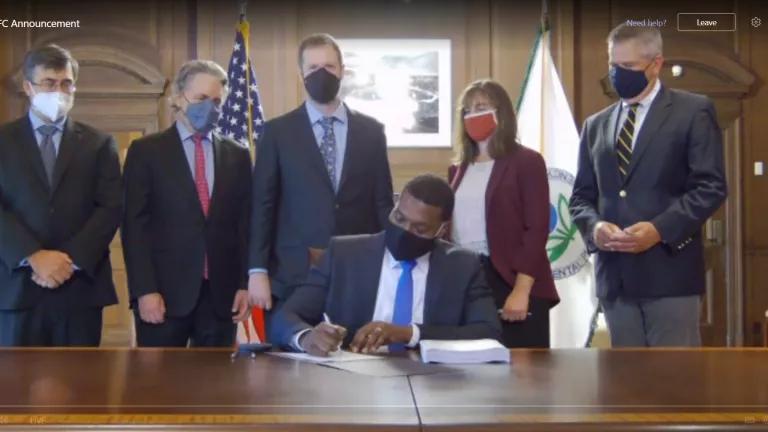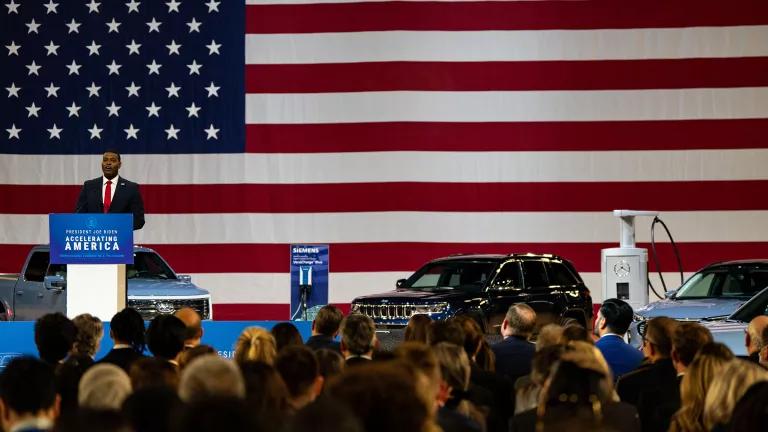EPA Moves Fast to Curb HFCs
The benefits of the new rule are huge, and it’s a significant step toward President Biden’s goal of cutting U.S. climate pollution by 50-52 percent by the end of this decade. But there’s plenty of work left to do.

Administrator Michael S. Regan signing the HFC rule during a virtual ceremony on Thursday September 23, 2021. Behind him EPA officials (from left to right): Tomas Carbonell, Joe Goffman, Luke Hall-Jordan, Cindy Newberg, Chris Grundler.
The US Environmental Protection Agency (EPA) finalized an important rule yesterday to phase down the supply of hydrofluorocarbons, or HFCs, the potent greenhouse gases used in refrigeration, air-conditioning and many more applications.
The top line is very good—EPA’s new regulation mostly holds the line from its proposal, particularly where it matters most. The benefits of the new rule are huge, and it’s a significant step toward President Biden’s goal of cutting U.S. climate pollution by 50-52 percent by the end of this decade. But there’s more to the story and plenty of work left to do.
Phasedown and Allocations
First, a quick recap. EPA’s action carries out the core obligation under the American Innovation and Manufacturing (AIM) Act, signed into law nine months ago, to cap and phase down the supply of HFCs by 85% over the coming 15 years.
Each year the HFC industry will receive a limited number of allowances authorizing ongoing production and import of HFCs, weighted by each chemical’s global warming potential (GWP) and dwindling with time. The rule spells out how the first two years (2022-2023) of the HFC phasedown will go. Next year, EPA will begin a second rulemaking to improve the HFC phasedown program for 2024 and beyond. That rulemaking will address a number of issues and potential solutions on which EPA took advanced comment this summer.
Even though this regulation is only the first step in a 15-year phasedown, it’s a big deal. It’s EPA’s best shot to start off on the right foot by setting up a framework for phasing down HFCs that is equitable, flexible, achievable, and ambitious. If implemented correctly, this action will achieve remarkable emissions reductions.
To give you a sense of magnitude, EPA estimates:
“The total emission reductions of the final rule from 2022 to 2050 are projected to amount to the equivalent of 4.6 billion metric tons of CO2—nearly equal to three years of U.S. power sector emissions at 2019 levels. In 2036 alone, the year of the final reduction step, this rule is expected to prevent the equivalent of 171 million metric tons of CO2 emissions—roughly equal to the annual GHG emissions from one out of every seven vehicles registered in the United States. A global HFC phasedown is expected to avoid up to 0.5°C of global warming by 2100.”
The rule provides total climate and economic benefits of $273 billion through 2050.
Enforcement
In addition to limiting overall HFC supply, the regulation lays out a suite of innovative enforcement tools to make sure importers, producers, and everyone else play by the rules. It’s an impressive list that includes audits, reporting, QR codes on HFC tanks and cylinders, and after a phase-in period, bans on the use of non-refillable cylinders.
Administrator Regan also announced the creation of an inter-agency enforcement task force led by EPA and the Department of Homeland Security (DHS), to block illegal HFC imports. This effort reflects learning from the European Union, whose HFC program has suffered from illegal imports over the past few years. If we experienced non-compliance levels similar to those observed in the EU, we would exceed our national consumption target by the equivalent of 43-90 million tons of carbon dioxide in 2022, significantly threatening the climate benefit of the rule and undercutting compliant domestic manufacturing.
EPA and DHS will need all the help they can get; while the rule eventually bans non-refillable cylinders and improves tracking with QR codes, EPA ceded to industry pressure and delayed full implementation of those to 2027. By the time these enforcement tools become fully effective, we’ll be well along on the phasedown. In the interim the EPA/DHS task force will have to contend with illegal imports without all these tools.
In addition to the phasedown framework, EPA took action on two important matters.
Curbing the Worst HFC of All
The rule curbs emissions of HFC-23, an incredibly climate-damaging byproduct of producing other chemicals—packing 14,800 times the climate-warming punch as carbon dioxide, pound for pound. The rule requires all plants to capture and destroy HFC-23 starting October 1st, 2022, using EPA-approved destruction technologies. Companies can choose to capture HFC-23 for some niche uses, such as for very low temperature refrigeration, but they will have to expend allowances to do so, and with its extraordinarily high potency, that will use up a lot of allowances. EPA released a similar proposal earlier this week covering HFC-23 emissions from certain hydrochlorofluorocarbon plants, as part of a smart belt-and-suspenders approach to make sure HFC-23 emissions are promptly and permanently terminated.
Environmental Justice
EPA took a harder look at potential environmental justice implications of this rule than we’ve seen before and promised to take several important steps. Community exposure around the eight production plants stems primarily from releases of toxic chemicals such as carbon tetrachloride and hydrogen fluoride, a fraction of which is associated with HFC and HFO (an HFC alternative) production. Existing releases around these facilities are disturbingly high and could potentially increase if production shifts between plants without safeguards.
EPA stopped short of putting in place the comprehensive guardrails on HFC production allowance trading NRDC called for. Nor did it adopt a zero-tolerance policy towards avoidable toxic releases from HFC and HFO production for participants in the allocation program.
The current rule, however, adds a new layer of transparency to emissions reporting. So far, information about the production levels of HFC plants has been treated as confidential business information (CBI), which has made it difficult to track potential toxic releases associated with HFC production. In this rule, EPA clearly stated its intent to no longer treat this information as CBI and will release chemical-specific, facility-level information to the public. The timely and transparent release of data will allow us to monitor whether there are unintended local pollution burdens resulting from the phasedown and will give us the tools to keep companies and EPA accountable. We’ll keep our eyes on the data, and if we find problematic trends, we’ll be ready to pursue additional guardrails and more when EPA revisits the HFC phasedown framework starting next year.
HFCs in Imported Products
In our comments, we noted that HFCs imported inside foreign-made products, such as fridges and air conditioners, have grown to account for about 10 percent of our country’s total HFCs. EPA declined our request to require those importers to have HFC allowances. But the agency appears to be planning to grant petitions, filed by NRDC, environmental partners, states, and industry, for rules to ban the use of high-GWP HFCs in such products, regardless whether they are made here or abroad. The deadline for action on those petitions is October 10, and we’ll be pressing for strong rules.
EPA’s start was a good one. There’s a lot to like in a regulation that took EPA’s crack team just 270 days to put together, meeting the statutory deadline. The work continues.






